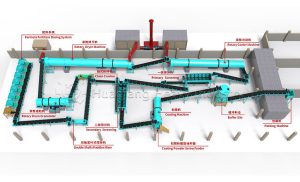Introduction
In agricultural production, NPK compound fertilizer, with its balanced ratio of nitrogen (N), phosphorus (P), and potassium (K), is crucial for increasing crop yields. However, the effectiveness of compound fertilizer is closely related to its physical properties, with pelletization efficiency directly impacting fertilizer utilization, storage stability, and ease of mechanical application. Our company’s fertilizer granulators can achieve pelletization rates exceeding 80%, significantly improving fertilizer quality and production efficiency.
To meet diverse customer needs, our company primarily offers disc granulators, rotary drum granulators, and double roller press granulators.
The difference between three fertilizer granulators
The disc granulator and the rotary drum granulator use the wet granulation process, while the roller extrusion granulator uses the dry granulation process. The wet granulation technology is to add a certain amount of water to the fertilizer in the fertilizer granulator. Among them, the disc granulator and the rotary drum granulator are two widely used fertilizer granulation equipment. The reason for their wide use is that the disc granulator and the rotary drum granulator can be used not only for compound fertilizer granulation production, but also for organic fertilizer granulation production.The production rate of the disc granulator is more suitable for small-scale production, while the drum granulator is more suitable for large-scale production.
The double roller press granulator uses dry granulation technology, which directly uses physical methods to directly put the mixed powdered NPK fertilizer into the double roller press granulator for fertilizer granulation. In addition, the finished NPK fertilizer granules do not need to be dried or cooled.Compared with disc granulator and drum granulator, the investment cost of double roller press granulator is much lower.



